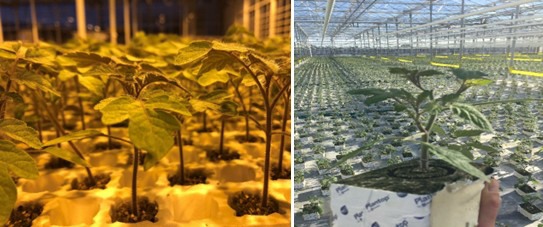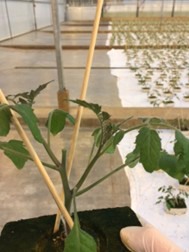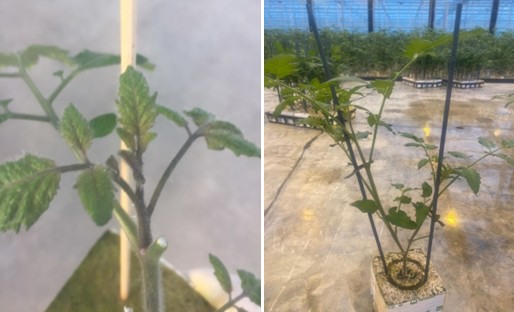Winter in the Northern Hemisphere and the tomato planting season are almost behind us, and we're heading towards spring. The perfect time for Jean-Claude Wex from Active Horti Ltd. and Hans van Herk from Propagation Solutions to provide some joined highlights about propagation tricks; especially in terms of dealing with sensitive varieties to propagate 2-3 headed plants, during wintertime. Problems like blind heads after the 1st / 2nd cluster can occur (> 30%), and shoots can develop very unevenly - so stay focused.
Similar to dancing, two partners are needed for grafting as well, in this case, a rootstock and a variety. Plant energy is the driver behind purple stems, dark green leaves, and a lot of roots. A general name for this would be energy.
To create a smooth healing process for the grafted plants, careful preparation is needed. As the healing process requires high temperatures (22-23 °C) and a very high humidity for some days (100%), it's a very vegetative situation.To deal with that, the following points are really important:
- Making sure rootstocks have a nice, active root system and enough anthocyanin before grafting, this requires a good watering strategy. Spacing them when the first leaf is visible also helps a lot;
- Hardening both rootstocks and varieties in a colder but active compartment, at around 15 °C really helps. Rootstocks can stay there for a week; varieties for about 2-3 days;
- Making sure that scions have enough energy / anthocyanin before grafting. That energy will support the development of future shoots;
- Pinched tomatoes on the 2nd leaf need to be grafted above the cots. Distance between the internodes needs to be < 1.2cm to avoid apical dominance later on.
 Strong rootstocks on the left and an energetic 3-header on the right
Strong rootstocks on the left and an energetic 3-header on the right
2. Transplant
When plants heals, they are mostly transplanted straight into a block. Make sure EC in the blocks is lower (recommended is 2.5 - 3) than EC in the plugs, as this will enhance the root system to establish itself and support the leaf growth.
The blocks must be fully saturated, so 10*10*6,5 must have a weight of 560 grams. All other volumes can be related to this number.
The average 24-hour temperature must be 21 °C , with a difference of 1-2 °C day / night. A small boost of 1-2 °C in the day peak would be really good.
In this stage, the light level must be used to build up the energy in the plants, so they stay compact. Propagators with high light levels can use, for example, 120 μmol for a max of 16 hours / day and shut them when outside light is above 250 W/m2 in autumn. In winter time this can be lowered to 150-175 W/m2.
As many propagators have lower artificial light levels, like 70-90 μmol, they can compensate for this in hours so they can use the lights for 18 hours, which is the maximum for tomatoes.
As the blocks are tight at this stage it's pretty important to activate the climate seriously. The result is that the humidity deficit stays between 3 and 7 g/m3. This is important as the micro-climate around the blocks is very humid (blocks are completely saturated) and evaporate water.
A minimum pipe at 38-40 °C can be very useful, although it's an energy consumer. Luckily, these young plants don't need too much. If the minimum pipe is combined with a small boost in the middle of the day, it can cut both ways.
Tight interim spacings works fantastically at this stage. They will break down the micro-climate and control the compact attitude.
3. Pinching on cotys & leaves
Pinched tomatoes for 2-3 shoots are very common for growers nowadays to order at propagators. It saves money on seeds, blocks, and more, and it can create a more generative plant compared to single headers.
a) Pinched cotyledons
Pinched on cotyledons is in winter time a tougher one as it needs more time (shoots are coming out of small cotyledons) and they are pretty sensitive to low radiation. But mostly, the 1st cluster has a better quality, so in sunny regions like the Mediterranean area or Oceania this is a good option.
This pinching is done on the trays with a high density as all the other circumstances (volume of air, radiation, limited substrate volume, density) are very generative to them and they'll get blocked easily. In sunny conditions, with radiation peaks of over 225 W/m2, this can lead to serious percentages of blind plants.
 The solution for this type is to keep their blocks tight for around 1 week. That will give them the opportunity to develop the shoots in a comfortable humidity conditions (nice micro-climate) and temperature (22-21 C). Lights can be on for 14-16 hours with 50-70 μmol.
The solution for this type is to keep their blocks tight for around 1 week. That will give them the opportunity to develop the shoots in a comfortable humidity conditions (nice micro-climate) and temperature (22-21 C). Lights can be on for 14-16 hours with 50-70 μmol.
Picture on the right: Pinched cotyledons
b) Pinched leaves
 This is the standard in Europe, mainly done on 2nd leaf and more and more on the 3rd leaf for 2-3 shoots. Also standard is to get them rooted in at first and then pinch them. Important points are:
This is the standard in Europe, mainly done on 2nd leaf and more and more on the 3rd leaf for 2-3 shoots. Also standard is to get them rooted in at first and then pinch them. Important points are:
- Established rooting systems give better shoots so wait for the roots to be visible at the bottom of the block;
- After pinching, keep the lights on, even for a few hours, to retain the energy;
- Dif in temperature work well, however, start small;
- Screens are perfect tools to save energy here but humidity can reach high levels when they are block tight. Interim densities help with this, but nevertheless, gapping the screen isn't an option.
Picture on the rigth: Pinched on second leaf
c) Other strategies
- Pinching in the tray before transplanting is feasible but could be too generative of an action on sensitive varieties to develop multi-shoot after pinching;
- Pinching at 3 leaves to get 2 shoots at that stage, selecting the strongest shoot letter on. Propagators with high artificial light levels can use this for varieties that have problems to create 2 good shoots. In France there are some popular varieties used that have problems with this, but all propagators face the same issue. Most of the time the bottom leaf is simply not strong enough. With a couple of days more this can be reached. It is still important to use high light levels, a dif in temperature and a humidity deficit > 3 gr / m 3.
d) Unequal shoots or blocked plants
As most propagators in Europe have light levels of around 50 – 70 μmol, the majority of varieties is propagated properly. But some varieties, new and old, face issues of blind heads and unequal shoots. The 1st is clearly bad but the 2nd also isn't great for growers.
The assimilates can simply become too much for the plant and they get blocked. Other conditions also play a big role like density, spacing moment, de-leafing, etc., all lead to the accumulation of assimilates. The reactions are strongly curved leaves, super dark green leaves, and no stretch anymore.
Some varieties have a bad performance in winter time facing low light conditions, snow, or too generative of an approach; they get blocked or uneven. This isn't easy to correct for the propagator as there's a lack of growing time to recover from an unequal start, resulting in uneven plants at delivery. Correction should be made on the shoot at least 7-10 days before delivery to show result.
 Blocked tomato – pinched on second leaf and on the right unequal after pinching
Blocked tomato – pinched on second leaf and on the right unequal after pinching
4. De-leafing = balancing
Sounds strange to take away leaves of the plant in wintertime. They need to capture the light don't they? But for pinched ones on the 2nd or 3rd leaf this is different. According to morphology, the 1st tomato leaf is not the same as the 2nd one. And if you take into account that the leaf is the motor for the shoot, it will become an unfair situation. The 2nd leaf will deliver more energy to the 2nd shoot compared to the 1st leaf so it needs to be balanced!!
This de-leafing needs to be done on the same day as pinching, or one day later. Afterwards the leaves lose their importance for the plants, and the hormonal situation has changed completely as of the pinching. The strategy is to de-leaf the top and second leaf. Keep no leaflet on the top leaf, and only 1-2 leaflets on the second leaf, do not de-leaf the bottom leaf.
De-leafing also stops the stretching between leaves 1 and 2. This gives the bottom shoot a much better opportunity to catch up with the 2nd one.
Once shoots are pinched on the 2nd leaf, shoots are 1.5cm, pre-space 25 blocks = 50 heads / m2. This will be a crucial transition for the plants to balance themselves and will increase DH (generative action), still at 21 °C average for 24 hours, with a difference of 1 °C between day/night.
At this stage, just pinched, the plants are sensitive to generative conditions like high radiation levels, too many hours / concentration of artificial light, low density, or small volumes. This sensitivity can result in blind heads, non-uniform shoots, or blocked plants as of too many assimilates.
Propagators with high levels of artificial lights, > 100 μmol, have to be careful and lower the concentration. When light levels are about 50-70 μmol, the need for decreasing hours and intensity is still there but less strong.
If natural light is there as well, the lights can be turned down. Levels like 175 – 200 Watt are pretty common.
Varieties also play a big role in this. The bigger the fruits (> 125 grams) or the more extraordinary (Coeur de Boeuf-types, black tomatoes, etc.), the more they can be affected.
In the last period before delivery, the plants reach their final spacing:
- plants are 4 leaves stage;
- 2 degrees difference day / night + pre-night of 16-17 °C;
- AVG 24 hours = 19,5 - 20 °C,
- 2 best shoots can be selected if pinched on 3 leaves
During the very last days of propagation:
- the plants are at 5-6 leaves on shoots;
- the AVG-temp can slowly go down with pre-nights to around 15-16 °C;
- keep it active during the day so grow on light (75-150 W = + 1°C and 150-250 W = +1°C);
- Pre-night has to be applied at 4 then 6 leaves stage. Earlier is also ok but then less steep and less strong;
- Artificial light 50 - 70 μmol max 16 hours / day if below 200 W/m2.
- Artificial light 100 - 120 μmol max 14 hours / day if below 200 W/m2.
The information above is a guideline. Many other factors can influence these sensitive varieties to get their shoots out nicely. Factors like:
- screening at a young stage;
- pinching in trays or in blocks;
- energy screen in winter;
- irrigation strategy (EC, pH, and Water Content management).
For more information:
Jean Claude Wex
Active Horti
jeanclaude.w@zealandia.co.nz
Hans van Herk
Propagation Solutions
hans@propagationsolutions.nl
